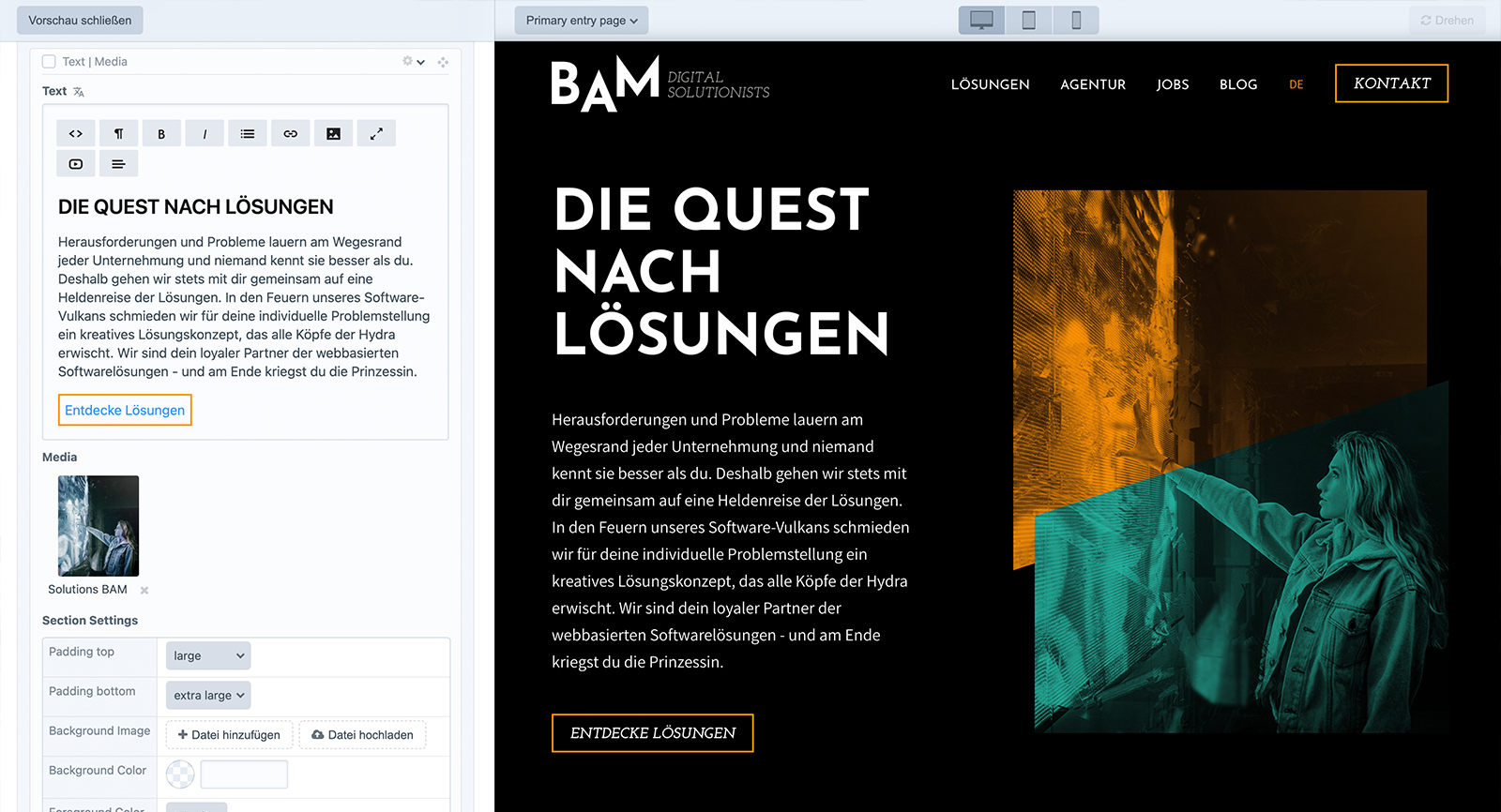Well... which CMS do you like? We can answer that quickly: The CMS of our choice is Craft. A decision that was easy for us on all levels. Our devs as well as content managers and editors quickly fell in love with this rather unknown content management system. We have summarised our reasons for that in five appetising bites.
1. Modern, modular, scalable
Craft CMS is based on modern technologies such as PHP, Composer, Twig, GraphQL or the Yii framework. These technologies are great for a variety of reasons. Take the Yii framework, for example: its great system architecture creates an orderly framework, a common basis for development and makes it easy for devs to understand third-party plug-ins. At the same time, it enables scalability in development. Via Twig, we can use Craft as a 'traditional' CMS for websites, while GraphQL ensures that we lose our heads. In the headless variant, you can drag content into separate applications via the GraphQL API - wherever you want to play out your content.
Thanks to plug-ins, Craft remains modular and we can use those to pimp the CMS and tailor them exactly to your requirements. We usually code the plug-ins individually, but there are also various good ones in the store that you can use for your project. For many important features, however, you don't need a plug-in at all, because Craft has a powerful core. For us, the best core features are multi-site and localisation, as we have to set up and control several multilingual CMS pages for many solutions. Especially for our internationally oriented customers, it is essential that they can display any content differently depending on the language or country. With Craft, this is possible with super performance and it can be controlled excellently. By comparison, localisation in WordPress only works via additional plug-ins, which are often very cumbersome to use.
2. Content can be maintained by a drunken monkey

Nothing against monkeys, they are great animals, but we have to emphasise this clearly. Almost all known CMSs claim that content can be maintained easily and intuitively, but Craft surpasses our previous experience. The causal chain "new agency -> new website -> new CMS -> nothing works without editor training" has already been broken several times in our case. potential training participants had logged in and explored the system themselves - and understood it. On the one hand, this is certainly due to the very self-explanatory and clearly structured editor, and on the other hand to the live preview, which you can activate with one click. The editor then reduces to about one third of your screen and on the other two thirds you see every change you make immediately in the front-end view of the website. This is a huge advantage for those who always have trouble assigning the modules in the backend and don't know exactly where they are making changes.
3. It really doesn't cost much
Costs are a relevant question when choosing the right CMS. As an open source CMS, the fees for Craft are low, as expected. Currently, the licence fee is about 260 € and the annual update fee is about 50 €. Besides new features and bug fixes, this of course also covers important security updates. If you want to see what the community is currently working on, you can easily do so via GitHub. And that's not all: you can even see what's coming on the feature roadmap and vote for the topics that are important to you. Open source communities are awesome, aren't they?
4. We can code anything we want

Freeeedooom!!! Adjustments and extensions of the CMS functions are easy for us in Craft. Sure, it's work, but pleasant work. After all, our master codas customise many plug-ins and modules to suit individual client needs, so good manageability is very important to us. Craft gives us the necessary freedom for this, because
- maintenance masks are freely configurable
- The CMS generally does not specify how content has to be structured
- it does not specify how the frontend has to be structured
- it leaves us free to choose frontend technologies such as Twig templates or Vue
These possibilities and the aforementioned features are not nice to have. They are much more a basic requirement for our work. We have the claim to develop high-quality solutions, and that is only possible with the necessary room for individuality.
And by the way, in WordPress, adjustments to maintenance masks can only be realised very awkwardly through plug-ins or individual development. Who would have thought that?!
5. Craft will take over the world sooner or later
At the moment, Craft still seems to be more of an insider tip, but we are fully convinced and see clear advantages over big players like WordPress, Joomla or Drupal. Worldwide, other people have already noticed this and around 80,000 installed Craft licences are a first indication of its rapidly expanding presence in the digital world. Speaking of 'worldwide': The World Wide Web Consortium (W3C) also relies on Craft and these dudes are concerned with the standardisation of techniques on the net. They explain their decision in an interesting article. Have a read. We are definitely infected and will continue to share our enthusiasm.
If you want to know more, have a look at https://craftcms.com/ or at Andrew Welch, who is the 'God of Craft'. Enjoy! 🤩